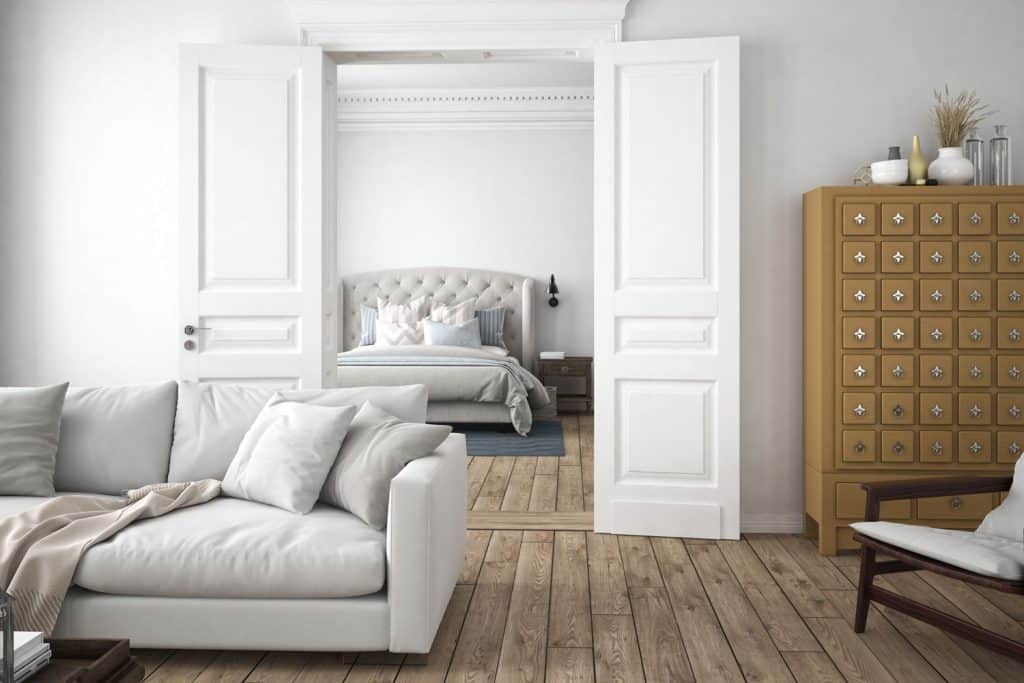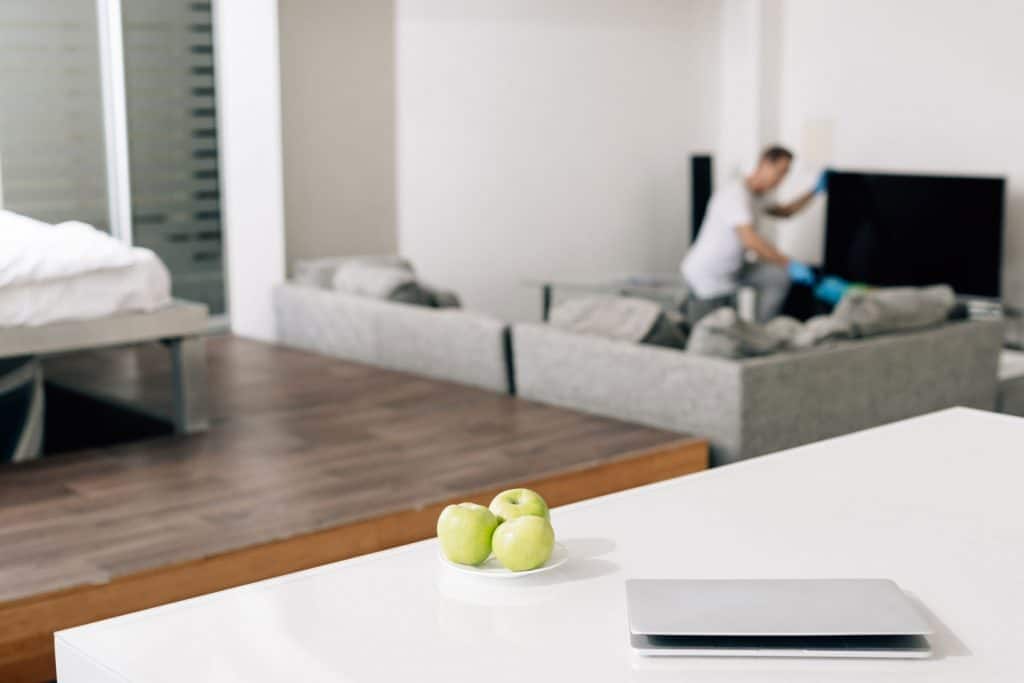If you have a living room that’s on the large side or on the small side, floating your furniture can help open up your design options. And for a smaller living room, it can help create more space in the room by adding a sense of depth and making the room appear bigger. To help give you ideas, we’ve researched a number of ways to float living room furniture, and in this post, we will share them with you.
Here are a few design techniques that you can use to float your living room furniture:
- Add in a writing desk
- Use different types of seating
- Make use of ottomans
- Make a loveseat & sofa face-off
- Used benches
- Toss in a large sectional
- Take advantage of natural lighting
- Create rows in the living room
Sometimes it helps to take a picture and briefly study a picture of your living room first before you move your furniture around. You’ll be surprised to learn that once you get those creative juices going, you’ll find that several ideas may come to mind, but in case they don’t, continue reading to learn about the various options available for floating your living room furniture.
Ways To Float Furniture In A Living Room

Add in a writing desk
A writing desk floated between two chairs can help to make your living room look more interesting. Place the chairs about 6 feet apart from each other and facing each other. Next, place the writing desk adjacent to the chair so that it’s facing the side of them.
Use different types of seating
Consider using varied seating for your living room and floating them in the middle of the room, around one another. For example, you can use a chair, loveseat, and a sofa and place them in a circular pattern to create a focal point within the room. You can also add an area rug beneath them for more layers.
Make use of ottomans
Ottomans can serve an aesthetic and functional purpose in a living room. Consider adding a couple of ottomans and placing them in front of two chairs or a sofa and loveseat in the living room. Keep in mind that everything doesn’t have to face each other. Consider using a rectangular layout or an oval layout to make the space appear bigger.
Find out more about this ottoman on Amazon.
Make a loveseat & sofa face-off
The great thing about love seats is that they can provide versatility in your living room. If you want to float your sofa, consider facing it directly across a loveseat with a small coffee table between the two. This is one of the simplest ways to float your sofa, but it’s also one of the most interesting looks. And don’t be afraid to add an end table or two to the edges of the couches.
Check out this end table on Amazon.
Used benches
Benches are definitely a good choice to make your living room stand out. Why? Because they are not typically seen in living rooms. Take a bench and line it up so that it’s adjacent to a sofa or loveseat. You can also use benches to create a square shape on opposite sides of two opposing couches.
Toss in a large sectional
If your living room has a sufficient amount of space, consider adding a large sectional to the middle of the room. Not only can you decorate the sectional with different-colored throws and pillows, but you can place tables, benches, and ottomans next to it to make the living room appear more dynamic.
Have a look at this bench on Amazon.
Take advantage of natural lighting
Another good idea is to place a couple of chairs near an open window. For example, if you have bay windows in your living room and like to read in the morning, have the back of the chairs facing the window and sitting across from a loveseat or sofa.
Create rows in the living room
Who said that floated furniture pieces have to be facing one another? Consider placing a roll of couches in the back of a couple of ottomans and then set a coffee table in front of the ottomans. If you use your living room for different purposes such as entertaining, gaming purposes, or reading, this layout can work well.
When Should You Float A Couch?

There are specific scenarios and layout conditions where floating a couch is the best thing that you can do for the room from a design standpoint. Let’s look at some of them.
Create a flow for the room
If you are looking to direct traffic toward a specific area in the room, floating the furniture can help to accomplish this. For example, you may want people to stick to the sofa and seating areas instead of the bookshelf or desk areas on the outer portion of the room. Items such as accent tables around the seating areas and adjacent ottomans can help make this happen.
Create the perfect conversation set up
It’s important to consider personal interactions when pondering how to set up a living or entertainment room. Pulling sofas together so that they face each other can make it easier for people to have casual conversations. This is a better option than placing one so far on one end of the room that it makes it hard to interact with someone sitting on the other softa. This is especially important for larger rooms where space isn’t an issue.
Maximize seating area
Sometimes smaller rooms simply don’t have enough space to decorate the way you want to. In this case, floating the furniture in the room can help you save space. This is especially true in scenarios when you need to blank tables around sofas.
Divvy up larger spaces
Floating furniture is also a good idea if you’re looking to separate the spaces in one room. This works well for rooms that are over 400 square feet. For example, you may have a multi-functional living room and want to keep the gaming area separate from the reading or seating area. Creating small hubs within a room can not only prevent the room from looking too spread out, but it can create setups such as an appropriately-sized conversation area or a stand-alone seating area for Sunday morning reading.
What Should You Put Behind A Floating Couch?
Sometimes it can seem challenging to find the right furniture piece to place behind a floating couch, Which is why we’ve come up with a list of ideas for you. Let’s take a look.
Add a desk
Desks don’t have to be restricted to home offices and bedrooms. They can go in any room. Suppose you need a functional furniture piece to help take up a bit of space in your room. Consider a desk. It’s a convenient place to toss your mail or place a few notepads and pencils for on-the-spot notes.
Have a look at this desk on Amazon
Squeeze in a small table
Consider adding a small table behind your floated sofa. A table can provide you with a quick place to set your books, reading glasses, or beverages. There are tons of small tables that fit in the 10 to 12-inch range, and many can be purchased online or at your local furniture store. You can also add a small lamp or tabletop plant to help decorate it.
Check out this mini table on Amazon.
Consider a small bookshelf
Bookshelves are wonderful living room options, as they not only provide quick access to books but they can make for the perfect decorative piece. If you have at least a couple of feet available behind your couch, considering throwing in a small bookshelf and adding your favorite novels to it.
Read more about this bookshelf on Amazon.
Slide in a bench
A small bench can be the perfect way to sneak in a bit of extra seating into your bedroom, entertainment, or living room. The great thing about benches is that they come in so many decorative options that it will be very easy to find one to suit your room decor. Consider an upholstered bench to add a bit of warmth to your leather sofa or a solid wooden bench to make your room look more rustic. You can also place a few small baskets on either side of the bench and use them for storing sewing materials, magazines, or other personal items.
Find out more about these baskets on Amazon.
How Do You Hide Cords Under A Couch?
You can hide a cord under a couch using a cord management kit and attach it to the bottom of the couch. Or consider placing an area rug that’s the size of the couch beneath it.
Check out this cord management kit.
How Do You Hide Cords Running Across The Floor?
Use the furniture
One of the best ways to hide cords across the floor is to camouflage them. You can run them under large furniture, bookshelves, potted plants, or camouflage them with floated furniture arrangements that keep them out of sight.
Run them along the baseboards
Sometimes it’s better to simply redirect power cords running across the floor to the perimeters of the wall. One great way to do this is to snake the cords through cord hiders and then run them along the baseboards. These accessories typically come in either black and white, though you can easily spray paint them to match your decor.
Check out this cord hider set on Amazon
Can A Couch Be Too Big For A Room?
Yes, a couch can be too big for a room. It’s important to measure the dimensions of a room and the potential couch before purchasing it. The reason is that the couch is usually the biggest piece of furniture in a living or dining room, so if it takes up too much space, you’ll have quite the challenge trying to add in the other furniture pieces.
Should Your Couch Face Windows?
Yes and no. Three things to consider before facing your couch towards the window are the current window dressings, the direction that the window faces, and the activity in the room. For example, if you like to read in the room during the evening and the window faces west, this can make it very difficult to do–especially if the windows don’t have full dressings.
Wrapping Things Up
We hope that this post has provided you with enough options to consider for floating your living room furniture. It’s always a good idea to measure your large furniture pieces beforehand to decide which layouts will work best for your space.








